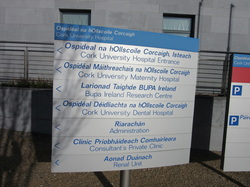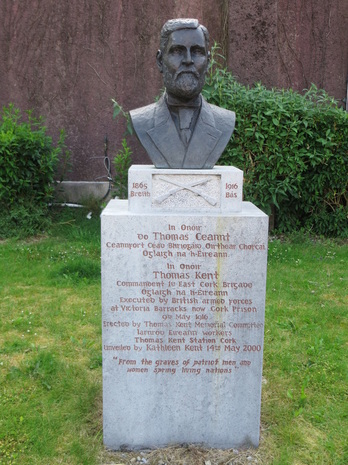News reports reminded of this plaque close to the church in Ovens, Co. Cork which I spotted a while back.
When there is a name and an image, it lifts the news beyond cold facts and numbers.
Twenty three years old and setting out on a new challenge.
Using signs, advertisements and messages as the inspiration for observation and comment - enlightened and otherwise
|
Yesterday was the anniversary of the sinking of the Titanic. 104 years ago, on 15th April, 1912.
News reports reminded of this plaque close to the church in Ovens, Co. Cork which I spotted a while back. When there is a name and an image, it lifts the news beyond cold facts and numbers. Twenty three years old and setting out on a new challenge.
3 Comments
I have never seen a plaque like this before.
This plaque is on the R360 in Co. Galway, a bit south of Williamstown. As with many plaques, it gives an outline but does intrigue a bit as to the full story. Why did the Shally family leave? Was it their choice or were they compelled by the Land Commission; or a landlord; or even for reasons of work? Did they own the house? If so, was it sold or does it remain in the family? Why move to Tulsk in a neighbouring county? Because of the unusual message on the plaque, to me it definitely asks more questions than it answers.
I have spent whatever free time over the Christmas mapping the nearly-200 memorials to War of Independence and Civil War that I have photographed over the past few years,
The map can be viewed HERE. Only some of the Limerick and Kerry memorials have the photographs uploaded – next task is to upload all the other photos. Century Ireland tweeted that yesterday was the anniversary of the birth of Hugh Lane, born on 9th November, 1875.
It reminded me of this plaque at St Luke’s Church in Douglas. I understand, from talk on Heritage Day, that he was born in Douglas, at Ballybrack House on Donnybrook Hill, and christened in the church but, that that was the extent of his time spent in Cork as soon after he was brought to England where he grew up. Féilire Gaeilge tweeted today to say it was the anniversary of the death of Charles DeGaulle.
It reminded me of this monument that I spotted in Sneem last year and had mentally filed away as to why it had been erected. It appears that he visited on a number of occasions and that the monument was erected in 1994, 25 years after his visit in 1969. More work of Seamus Murphy that I spotted this week – after my conversational Irish class.
That is some beard that Mr Dunlop had. Considering that John Boyd Dunlop died when Seamus Murphy was only fourteen, I wonder what he had to work on to create a 3-D image. The plaque is not very prominently located – considering this is my third year attending at the O’Rahilly Building each Wednesday evening of a 20 week course and this was the first time that the corridor door was open and I saw it. Today’s update from Stair na hEireann, told of a skirmish at Ballineen and Enniskeane in West Cork. “1922 – Skirmish between National Army and Republican troops who attack military posts in two villages, Enniskean and Ballineen in West Cork. Five Free State soldiers are injured, two fatally. Republican losses are at least two dead; a section commander Tadhg O’Leary and a volunteer, both IRA West Cork Brigade” The plaque on the building in Enniskeane confirms one of the dead as John Howell who was some distance from home.
The plaque to Timothy O’Leary’s is in the adjoining village of Ballineen. I definitely need to allocate time to upload all of the photographs of the Civil War/ War of Independence memorials.  My schooldays finished over 30 years ago but the only word I recall ever being taught in Irish for ‘hospital’ was ‘ospidéal’. On Monday, I was cycling to collect our 9-year old from school and spotted this plaque at St. Finbarr’s Hospital on Douglas Road. It took a while to register but then came the eureka moment when I remembered last year a discussion as to ‘Othar’, meaning a patient. So, just as ‘Uachtarlann’ is a ‘creamery’ or more literally, ‘Cream Building;’ Leabhlarlann’ is ‘library’ (book building), and ‘marclann’ a ‘stable’, so ‘Otharlann’ is a ‘house of patients’. The CUH uses ‘Ospidéal’ and not ‘Otharlann’ so maybe ‘Otharlann’ is falling out of use in favour of English-ised Irish. That very morning the same 9-year old ‘corrected’ my use of ‘gluaisteán’ for ‘car’, saying that ‘carr’ was correct. It is interesting to note that Focloir.ie lists ‘carr’ ahead of ‘gluaisteán’ and also lists ‘ospidéal’ ahead of ‘otharlann’. After two years of conversational Irish class, I have now realised that language is not mathematical; that it does not always translates exactly; and that it is forever changing and growing. Continuing my cycle, I wondered as to how many other Irish words did I once know, that have now been replaced by an English-ised Irish word. However many there might be, I have not been able to recall another but suspect there are quite a few. This morning’s update from Stair na hÉireann advised that Eamonn Kent was born on this day in 1881.
I thought I’d share this photograph of the plaque on the house in North Co. Galway.  Last evening, my 9-year old and I went up to Collins Barracks, to St. Michael’s Garrison Church where the remains of Thomas Kent lay in state. As I have mentioned here before, my recollection of Intermediate Certificate history as taught in my particular Alma Mater is of events, places and people so distant in time and/or place. I never felt a connection or experienced a sense of inquisitiveness that I wished to pursue – something that I regularly encounter now when seeing a commemorative plaque. I have no recollection of a school education on Fenian times, the Easter Rising or the War of Independence/Civil War period. Any interest, you may have observed in blog posts hereabout, are without the foundation of directed school learning. The 9-year old did not enjoy the queuing too much. The ceremonial aspect of the changing of the guard definitely grabbed attention. The signing of the book; the photographers, the Mayor of Derry and Cork Lord Mayor; the guns; the guard of honour with heads bowed in respect; and, the flag over the coffin – there were all registered in the young mind. My hope is that when it comes to Junior Cert history and the period of Republicanism, Proclamation and Civil War, that there will be a memory of last evening that will inspire interest and inquisitiveness which hopefully will lead to a greater understanding than this parent.
It was today that I leant of the connection between these two memorials.
|
AuthorFrom Cork. SUBSCRIBE
Unless otherwise specifically stated, all photographs and text are the property of www.readingthesigns.weebly.com - such work is licenced under a Creative Commons Attribution - ShareAlike 4.0 International Licence
Archives
April 2024
Categories
All
Blogs I Read & LinksThought & Comment
Head Rambles For the Fainthearted Bock The Robber Póló Rogha Gabriel Patrick Comerford Sentence First Felicity Hayes-McCoy 140 characters is usually enough Johnny Fallon Sunny Spells That’s How The Light Gets In See That Tea and a Peach Buildings & Things Past Built Dublin Come Here To Me Holy Well vox hiberionacum Pilgrimage in Medieval Ireland Liminal Entwinings 53degrees Ciara Meehan The Irish Aesthete Líníocht Ireland in History Day By Day Archiseek Buildings of Ireland Irish War Memorials ReYndr Abandoned Ireland The Standing Stone Time Travel Ireland Stair na hÉireann Myles Dungan Archaeouplands Wide & Convenient Streets The Irish Story Enda O’Flaherty Cork Archive Magazine Our City, Our Town West Cork History Cork’s War of Independence Cork Historical Records Rebel Cork’s Fighting Story 40 Shades of Life in Cork Roaringwater Journal |